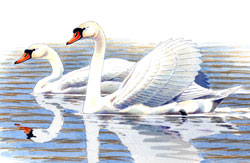Breeding Bird Atlases (BBA)
Find a Bird - BBA1
Breeding Bird Atlas 1 Species Accounts
Mute Swan
Cygnus olor
Egg Dates
April to third week of May
Number of Broods
one; may re-lay if first attempt fails.

This naturalized resident of the Northeast has established a breeding population, with increasing numbers, primarily along the southeastern coast of Massachusetts. During the nineteenth and early twentieth centuries, Mute Swans from Eurasia were imported by estate and park managers, and it is thought that our population stems from escaped and released birds from that era. Through the 1960s, breeding was irregular, and most swans were considered to be wanderers. By 1974, there were nearly 200 birds reported on Christmas Bird Counts in Massachusetts. During the Atlas period, numbers continued to build.
A post-Atlas survey conducted in 1983 showed a breeding distribution that approximates that of the late 1970s. Nesting Mute Swan pairs were reported from Westport to Dennis along the southeastern coast, from the Islands, and on the South Shore from Plymouth to Cohasset. A few isolated pairs nested on the North Shore. None were discovered breeding inland or on outer Cape Cod. The total for eastern Massachusetts was approximately 135 pairs. The areas with the greatest density included Martha’s Vineyard with 35 pairs, Falmouth with 20+ pairs, and Plymouth with 15+ pairs (Clapp, Hall).
Usually beginning in April, a pair of Mute Swans chooses a site at a coastal pond or tidal creek, where they build a large nest of vegetation lined with feathers. They are highly territorial at this time and will defend their nest areas from other swans, geese, ducks, dogs, and even humans, biting and delivering blows with their wings. The usual clutch size is four to six grayish eggs, which the female will incubate while the male remains on guard nearby. Hatching usually takes place within five to six weeks. Young cygnets are precocial, and the first ones to hatch will often join the male on the water while the female attends to the remaining eggs. Broods of three to four small cygnets are commonly reported, generally beginning in mid-May. The young stay with the adults for about fifteen weeks until they are able to fly.
Breeding success appears low, and all data and observations suggest a high mortality of cygnets. In Rhode Island, only about one-third fledge, and the same can be assumed from the 1983 Massachusetts data. There is continued mortality until the birds are old enough to breed. Unmated birds often flock together, creating a situation in which avian disease can produce significant mortality. Those that survive to adulthood have an average life span of six to ten years.
This easily recognized regal bird has developed a human following. Feeding swans, protecting them from interference, and harboring them in other ways have led to a proprietary relationship with the birds. There have been some concerns expressed about swans uprooting aquatic plants, stirring up pond shallows, and damaging shorelines through compaction and excessive guano production. There have also been worries about possible competition with other species of waterfowl, as well as confrontations with humans. In Rhode Island, a swan control program was initiated, but intervention has not been warranted yet in Massachusetts. The current population seems stable, with approximately 135 breeding pairs and a wintering number approaching 600.
Mute Swans are permanent residents of the coastal plain, moving to unfrozen ponds and bays for the winter. Migration is weather dependent and seems to be minimal. The great fluctuation of birds recorded on the Martha’s Vineyard Christmas Bird Counts may be due to varying conditions along the mainland coast. During severe weather, the swans leave areas that have frozen over and move to the more moderate island regions. However, some population variations do not seem to be related to the weather, and it may be that migration is more significant than assumed. Wandering individuals occasionally turn up at inland locales.
Map Legend and Data Summary
Atlas 1 data collected from 1975-1979


Note: locally common along southeastern coastal plain and islands; spreading and increasing
David E. Clapp



